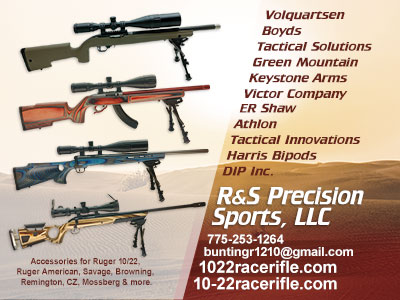
Boattail or Flat Base?
Does the base of your bullet make a difference at the ranges you hunt?
Story and Photos by Phil Massaro & Massaro Media GroupThe Lichtenstein’s hartebeest bull was feeding slowly across the dried pan in the Ikuria block of Tanzania’s Selous Reserve, just over 300 yards from where we stood.
Professional hunter Terry Calavrias and I agreed that the shot could be taken if I could get down prone, across a log that was conveniently placed in just such a position as to provide a solid rest. Once situated firmly on the Tanzanian soil, I raised the cross hairs just over a foot above where I wanted the bullet to strike, and broke the trigger of the Winchester Model 70.
The .416 Remington Magnum sent the 400-grain Swift A-Frame exactly where it needed to go, and the solid “whunk” of the bullet striking flesh came back to us on the midday breeze. We soon stood over a handsome kongoni dume, and the celebration began. The heavy, flat-nosed semispitzer bullet did more than its part.




It was an eye-opening experience for me, and some of the older ideas regarding bullet choice were rewritten in my mind. The boattail bullet design is most certainly an excellent choice for retaining velocity and resisting the effects of wind deflection. By changing the profile of the rear of the bullet from a flat-based design to an angled, tapered design, the air flows around the base of the bullet in flight and that projectile will slip through the atmosphere with less drag.
Few people would consider using a flat-based bullet to punch a steel target 1,000 yards away, as the velocity will drop off quickly and the wind will wreak havoc with the design. For this application, you see, it all comes down to the ballistic coefficient, that unitless number that compares the characteristics of a given bullet to a model of a particular shape. The higher the ballistic coefficient, the better the bullet will slip through the atmosphere.
So for target and other long-range work, a long, sleek ogive – that portion of the bullet that is curved, and tapers down to the pointed nose or meplat – and a boattail make all sorts of sense. But does that fact make the flat-based bullets (and those with a flat or round meplat) obsolete, or even insignificant? It depends entirely upon the application at hand.

But does a hunting bullet need the same conformation as a long-range target bullet? Does the highest ballistic coefficient matter to the hunter? Let’s take a long look at this, in order to choose the bullet conformation that will best serve you in your hunting scenario.

Before I was able to travel to hunting destinations outside my home state of New York, my big game hunting was limited to whitetail deer and those black bear residing in the Catskill and Adirondack Mountains. I couldn’t afford a dedicated varmint rifle, and there weren’t enough coyotes to speak of, so the majority of my time with a center fire rifle was spent in the woods, where shots rarely exceeded 100 paces.
This is typical of most hunting in the Northeast, and at that distance, the shape of the bullet matters not, as the time of flight is so short that the effects of atmosphere, wind and other factors just don’t come into play. The lever-action cartridges like the .30-30 Winchester, .32 Winchester Special, .35 Remington and .38-55 Winchester have shined in these scenarios, and all normally use projectiles that have less than desirable ballistic coefficient values.
What a world I’d find once I began to travel. Caribou bulls out across the taiga as far as I could discern, pronghorn antelope on distant hillsides, herds of eland better measured in portions of a mile rather than in yards; all presented a unique set of challenges to a kid whose longest shot might have been 175 yards. These experiences caused me to adopt the boattail spitzer as my bullet of choice, yet these came with their unique challenges as well.
With the cup-and-core bullets, I have found the jacket and core can, and will, separate during the terminal phase. This phenomenon results in poor penetration, and a long tracking job in some instances. In those rifles that have a less-than-perfect crown, accuracy can be more erratic with boattail bullets than with the flat-based choices. Now may be a good time to examine the effects on trajectory and wind deflection at hunting distances.

My own personal shooting distance limit while hunting is 400 yards, but I’ll extend the data out to 500 yards for comparative purposes. We’ll also use a 200-yard zero for all three bullets, common in many hunting scenarios, and examine data at 300, 400 and 500 yards. The G1 ballistic coefficients of the trio are .474 for the Partition, .500 for the Trophy Bonded Tip and .507 for the AccuBond.

even at 500 yards, the separation is a mere 1.3 inches, with the drop being 48.7, 47.7 and 47.4 inches, respectively. That difference is smaller than most hunting rifles can deliver at 500 yards, especially under field conditions. What about retained energy? At 500 yards, the Partition still carries 1,348 foot-pounds of energy, while the boattail designs retain a bit more at 1,408 and 1,423, respectively. Still not a huge difference.
What effect does the wind have on the trio? A 10 mph wind for the 500-yard shot will see the Partition drift 20.7 inches, the Trophy Bonded Tip 19.4 inches and the Nosler AccuBond will be blown 19.0 inches off course. Not really a big difference, considering the 500-yard distance and the performance of a hunting bullet. Assuming accuracy of one-MOA, there would be a 5-inch group on the target; one might say that the differences between these three bullets may be nullified, depending on which load your rifle shot best.





